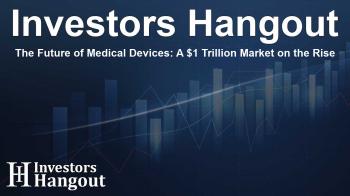The Future of Medical Devices: A $1 Trillion Market on the Rise

Projected Growth in the Medical Devices Market
The global medical devices market is on a remarkable growth trajectory, with a forecasted increase from USD 551.3 billion in 2024 to almost USD 1 trillion by 2034. This upward trend shows the demand for various devices driving the market, particularly in vitro diagnostics and comprehensive healthcare solutions.
Key Factors Driving Market Expansion
The surge in the medical devices market can be attributed to several crucial factors. The aging population is leading to a rise in chronic diseases, thus increasing the demand for effective medical interventions. Additionally, technological advancements are paving the way for innovative medical solutions, such as telemedicine and wearables that enhance patient care and monitoring.
Focus on Preventive Care
One of the primary growth drivers is the shift towards preventive healthcare. There is a growing emphasis on early disease detection and management, which elevates the demand for diagnostic tools and monitoring devices. This focus not only improves patient outcomes but also aligns with healthcare providers' strategies to mitigate long-term costs.
Personalized Healthcare Demand
There's an increasing demand for personalized healthcare solutions. Devices that can adapt to the specific needs of individuals, such as customized glucose monitors and personalized insulin delivery systems, are becoming increasingly popular. This personalization enables better management of chronic conditions, a trend that significantly impacts market dynamics.
Regions Leading the Market
Northern America has established itself as a leader in the medical devices market due to robust healthcare infrastructure and significant investments into research and development. The rapid growth in the Asia-Pacific region, particularly in countries like China and India, is also notable. These countries are enhancing their healthcare capabilities and manufacturing capacities, allowing them to capture a larger market share.
Technological Advancements Fuel Growth
Innovations in technology, particularly in medical devices, are expanding industry capabilities. Artificial intelligence, machine learning, and integrated health technologies are at the forefront of these advancements. These innovations enable healthcare providers to deliver better diagnostics, treatments, and monitor patients in real-time, considerably enhancing the healthcare experience.
Market Segmentation Insights
The medical devices market has diverse segments, including in vitro diagnostics, diabetes care, surgical equipment, and imaging devices. Each segment presents unique growth opportunities driven by specific healthcare needs and technological advancements. For instance, in vitro diagnostics remain a dominant player in terms of market share, while diabetes care devices are expected to experience rapid growth in the coming years.
Challenges Facing the Medical Devices Market
Despite the positive outlook, the medical devices market faces several challenges. Stringent regulatory frameworks and lengthy approval processes can hinder product opportunity timelines. Manufacturers often face high costs related to innovation and production, which can affect product affordability and accessibility.
Addressing Regulatory Hurdles
To mitigate these challenges, companies are focusing on efficient regulatory strategies. Ensuring compliance while expediting approval processes remains a priority for industry players. Collaboration with regulatory bodies can smoothen the pathway for new innovations, ensuring that they reach the market promptly.
Adaptation to Market Needs
Companies in the medical devices market need to remain agile, adapting to changes in consumer preferences and technological advancements. This adaptability is key in maintaining competitiveness and ensuring that they meet the evolving needs of healthcare providers and patients alike.
Conclusion: Embracing the Future of Healthcare
As the medical devices market evolves, stakeholders must leverage the opportunities presented by advancements in technology and shifts in consumer preferences. Continuous investment in research and innovation will drive sustainable growth within this dynamic market landscape.
Frequently Asked Questions
What is the projected growth of the medical devices market?
The medical devices market is anticipated to grow from USD 551.3 billion in 2024 to around USD 1 trillion by 2034.
What factors drive the growth of medical devices?
Key drivers include an aging population, rising demand for preventive care, technological advancements, and personalized healthcare solutions.
Which regions are leading the medical devices market?
North America is the largest market, while the Asia-Pacific region, especially China and India, shows significant growth potential.
What challenges does the medical devices market face?
Challenges include regulatory hurdles, high development costs, and maintaining affordability in a competitive marketplace.
What is the significance of technological advancements in healthcare?
Technological advancements play a crucial role in improving diagnostic capabilities, treatment options, and overall patient care.
About The Author
Contact Addison Perry privately here. Or send an email with ATTN: Addison Perry as the subject to contact@investorshangout.com.
About Investors Hangout
Investors Hangout is a leading online stock forum for financial discussion and learning, offering a wide range of free tools and resources. It draws in traders of all levels, who exchange market knowledge, investigate trading tactics, and keep an eye on industry developments in real time. Featuring financial articles, stock message boards, quotes, charts, company profiles, and live news updates. Through cooperative learning and a wealth of informational resources, it helps users from novices creating their first portfolios to experts honing their techniques. Join Investors Hangout today: https://investorshangout.com/
The content of this article is based on factual, publicly available information and does not represent legal, financial, or investment advice. Investors Hangout does not offer financial advice, and the author is not a licensed financial advisor. Consult a qualified advisor before making any financial or investment decisions based on this article. This article should not be considered advice to purchase, sell, or hold any securities or other investments. If any of the material provided here is inaccurate, please contact us for corrections.

